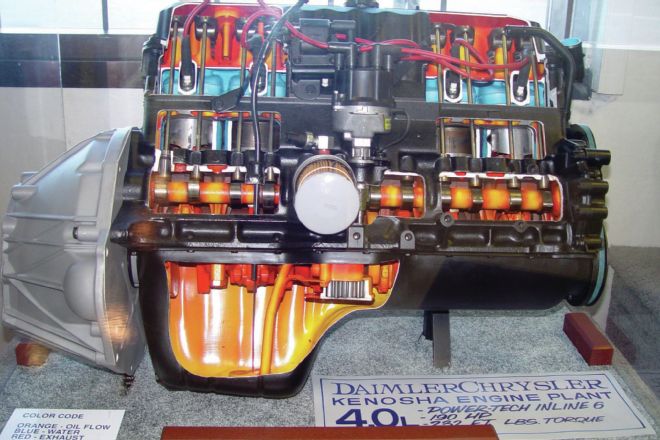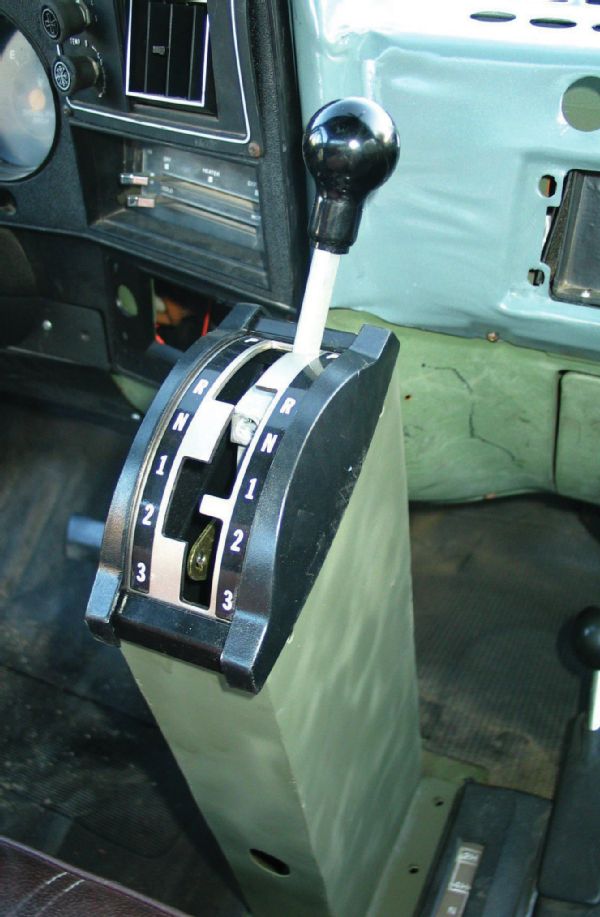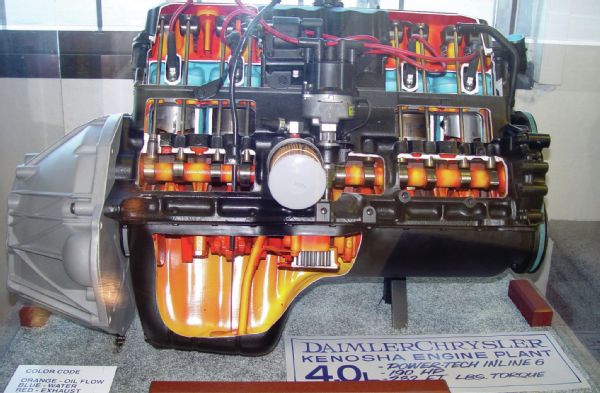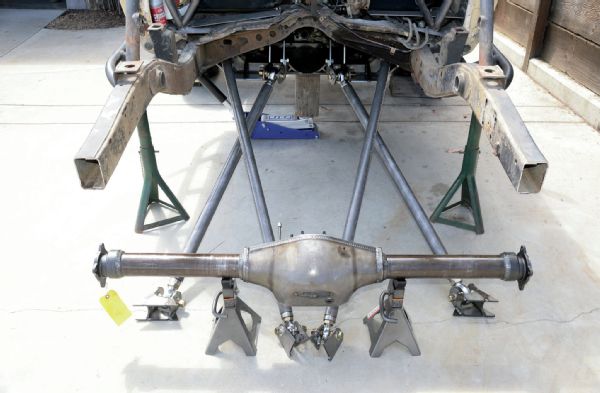
 John Cappa
Former Editor, Four Wheeler
John Cappa
Former Editor, Four Wheeler
Shifting GI Gyp
Regarding “GI Gyp” (Oct. ’14), what does the shifter look like? I really like the seat setup.
David Hellman
xtreme4x4tours.me
Via facebook.com/JohnCappa4x4

The traditional column shifter found on most fullsize 4x4s isn’t a first choice for off-road use. It can be difficult to figure out what gear you are in without pulling your eyes off the road or trail. Toggling the column shifter from Drive to Reverse is also cumbersome in sketchy situations where you need to quickly back down a hill. Early on (“GI Gyp,” May ’14), I removed the factory column shifter and mechanical shift linkage. I replaced it with a Winters cable-operated gate shifter from Poly Performance (polyperformance.com). These shifters are extremely common in the off-road racing world because of their dirt-simple function and reliability. To put the shifter in a comfortable position, I built a shift tower similar to what you would find in an M35A3 military truck. The M35A3 shift tower, and maybe even the shifter, could be adapted to a fullsize truck or other 4x4. You can commonly find the M35A3 shifters and shift towers on eBay (ebay.com) if you decide to go that route.
XJ Axle Swap
I have a ’93 Jeep Cherokee with the 4.0L and a five-speed manual transmission. I want to swap in a pair of axles from a ’73 Ford F-100. The rear is a Ford 9-inch, and the front is a Dana 44. Would you recommend a four-link in the rear with coilovers or leaf springs? This will be a trail-only rig. I intend to run at least 4.88 gears and 35-inch tires. Will this gearset be enough for the 4.0L, or do I need to go to a set of 5.13s?
Glen Boren
Via email
The Ford axles you have picked up will make for a decent swap. The ’73-’86 Ford truck 9-inch rear axle has a ton of potential and can be easily adapted to your XJ. The 9-inch axle has an abundance of aftermarket parts available for it. You can increase the strength of this 9-inch with bolt-on parts that will allow up to 40-spline axleshafts, although in this application, the 40-spline ’shafts would be total overkill. The ’73-’79 Ford F-100 and F-150 front Dana 44 will be slightly more difficult to work with. The radius arm brackets can get in the way of whatever suspension you plan to install. However, utilizing these factory axle brackets and making use of the original Ford radius arms on your 4x4 could simplify your swap.
As for your rear suspension selection, it really depends on personal preference. A properly designed leaf-spring suspension can control axlewrap and provide plenty of suspension travel and flex in your application. A leaf spring suspension is also less expensive and much easier to design and build than a link suspension with coilovers. If you are familiar with suspension geometry and desire extremely flexible suspension, then the four-link might be the way to go. However, I have seen many poorly designed and unstable link suspensions that do not work as well as a leaf spring suspension off-road. You’ll likely find that you’ll need to add a sway bar to your rear four-link suspension. This will limit the articulation, but more importantly, it will help control body roll in tricky off-road situations like climbs and side hills.
Your gear selection is a much easier question to address. On an off-road-only 4x4, I’ll almost always steer into the deeper gears to improve overall performance. If top speed is not an issue, I’d recommend going with the deeper 5.13s. The deeper gears will help keep you from overworking the clutch off-road and make the Jeep more drivable with snappier throttle response.
Tappity Inline-Six
A co-worker is interested in buying a ’00 TJ with a 4.0L inline-six. He says it has a tappet tick when starting it and driving for a little bit, but then the tick goes away. If you turn off the Jeep and restart it, the tick starts up again until driving down the road. The oil level and pressure are good. Any concerns?
Casey Kay
Via facebook.com/JohnCappa4x4

The Jeep 4.0L has sort of become the 5.9L Cummins of the Jeep world because of its durability and reliability. It’s been my experience that pretty much all of the Jeep inline-six engines make some sort of noise. The early and later Jeep I-6 engines are very similar in design, and in most cases, they are bulletproof in stock form. I’ve seen older AMC 258ci inline-six engines somehow survive indefinitely on 5 psi of oil pressure. The 4.0L may make a few noises, but I don’t think it’s worth tearing down or avoiding the vehicle. Even making a noise like this, it will likely last up to and beyond 250,000 miles, as long as you change the oil regularly.
Toyotally
I’m trying to decide if I should put a trunion-bearing eliminator kit on my ’85 Toyota front axle or go with the bigger bearing kit. I’m not sure what would be better. I already have the eliminator kit, but I can put it on my other truck.
Zach Grossman
Via facebook.com/JohnCappa4x4
The factory Toyota solid axles are extremely durable in stock form. However, adding larger tires, driving aggressively, and ultra-low gearing can take their toll on the assemblies. Fortunately, there are plenty of aftermarket upgrades available. The trunion bearings in the Toyota knuckles can blow out if pushed beyond the original design parameters. Heavy side loads and high-speed bashing are usually the cause for this kind of damage. There are two upgrades available to strengthen the Toyota solid front axle in this area. Marlin Crawler (marlincrawler.com) offers the 25mm Steering Pin Upgrade Kit and Trail-Gear (trail-gear.com) has a Trunion Bearing Eliminator kit. The Marlin Crawler kit increases the diameter of the steering pins by almost 50 percent and comes with new heavy-duty trunion bearings that are 54 percent stronger than stock, thanks to an increased number of rollers in the bearings. The Trail-Gear kit eliminates the bearings entirely and replaces them with hardened greaseable kingpins. Both kits greatly improve the axle assembly and have advantages and disadvantages. For a daily driver, I’d probably steer towards the Marlin Crawler kit because the bearings will require less service. For a 4x4 that’s abused regularly and trailered to the trail most of the time, I’d probably go with the Trail-Gear Trunion Bearing Eliminator kit. The Trail-Gear kit makes the knuckles easier to remove in the field and has fewer components but requires regular greasing about every oil change.
Four-link Fundamentals
Can you give me some basic info on building a four-link suspension? What type of joints or bushings should I use? What size should the joints be? What size DOM tubing should I use? Can you explain triangulation basics?
Sean Yeo
Via facebook.com/JohnCappa4x4

Four-link suspensions have become the new buzz item around the 4x4 campfire. Unfortunately, there are a lot of pros and cons that come with adding a flexible four-link to your 4x4. A whole book could be written about how to build a four-link suspension that actually works. In many cases, a complex and expensive four-link really isn’t necessary. I’ve seen some people go to all the trouble of building a four-link, only to have it not perform as well as the leaf springs it replaced.
The first thing to consider is if you really need a custom four-link and if you can make use of the advantages. A properly-designed four-link suspension will completely eliminate axlewrap and allow the axle to move more freely over the terrain. It also makes the suspension much more tunable, which could be bad for those that don’t want to take the time to do the tuning required. Most people want to make the switch to a four-link because they believe it will give them more wheel travel. While this may be true in some cases, the factory frame, steering, engine, and other components usually get in the way and limit travel anyway. Besides, more is not always better. A 4x4 with a slinky suspension may be impressive on an RTI ramp, but when you get it out on the trail, it can literally rollover on itself. You typically need to limit the articulation with at least one sway bar.
The type of joints you should use will be dictated by the environments you encounter most often. If water crossings, mud, snow, and salt spray are in your 4x4’s future, you should steer clear of rod ends and go with something greaseable. In most cases, you want to use a joint that allows plenty of angularity. However, there are some four-link suspension designs that will require a less flexible urethane or Delrin bushing on one end of the link. Also, if you want the suspension to be less harsh, you’ll want to consider using a rubber or soft urethane bushing on at least one end of each suspension link.
Joint size will be directly related to the weight of your 4x4, tire size, how you plan to use the rig, and how often you will replace or rebuild the joints. For most applications, the equivalent of a 3⁄4-inch rod end can be used on the upper links and a 7⁄8- or 1-inch rod end can be used on the lowers. If your vehicle is small, light, with not a lot of power, then you can probably drop it down to a 5⁄8-inch upper and a 3⁄4-inch lower. Heavy-weight, high-power 4x4s with tires over 44 inches tall should be using the biggest joints you can afford. Many companies such as Currie Enterprises (currieenterprises.com) and Ruff Stuff Specialties (ruffstuffspecialties.com) offer quality suspension joints. EMF (emfrodends.com) specializes in heavy-duty and extra-large rebuildable rod ends for 4x4s. The company even offers the Frankenheim, a rebuildable rod end with an insanely large 2-inch-diameter shank that weighs in at 171⁄2 pounds without a bung or jam nut.
DOM tubing is the most cost-effective material for suspension links. The diameter and thickness of the tubing that you select will depend on the length of the links, the weight of your 4x4, and how you intend to use it. For example, rock-bound rigs will need more durable links than sand or mud 4x4s. In most cases 1.5-inch, 0.120-wall DOM can be used successfully on the upper links and 1.75-inch, 0.250-wall DOM can be used on the lowers. You can also sleeve 1.5-inch, 0.120-wall tubing into 1.75-inch, 0.120-wall tubing to achieve a near 0.250-wall thickness. If you are building a heavier 4x4 with 44-inch or larger tires, you will likely need to consider using larger tubing diameters.
Proper suspension triangulation and geometry is extremely important when designing a four-link. It’s good idea to thoroughly understand all of the dynamics involved prior to cutting and welding anything. I highly recommend reading Chassis Engineering by Herb Adams. The book covers on-road race car designs, but it explains the forces you need to consider when building common automotive suspensions from scratch.
Austin Power steering
I’m having a problem with my full hydraulic steering. When I engage my 2.73:1 low range, I don’t have enough rpm to pump the fluid into the orbital valve. I’m stuck having to make a 50-point turn. The steering works great when I’m running in high-range in two-wheel drive.
Steven Ellis
Via facebook.com/JohnCappa4x4
Something isn’t adding up here. Engaging the low range will increase the engine rpm at a given vehicle speed. Increasing the engine rpm above idle will increase the power steering pump’s output. So, I’m not totally convinced that the issue you are having is steering related, although it could be. Because you are only having trouble in four-wheel drive, I kind of need to know more about your vehicle. If for some reason you have a spool in the front axle, I could see this kind of thing happening. A spool or welded front differential will not allow differentiation when turning. These types of traction-adding devices should never be used in a front axle unless your kind of off-roading only requires driving in a straight line, such as mud drag racing. If you have a selectable locker, you should unlock it when making sharp turns and only engage the locker when it’s needed. This will help preserve steering and axle components over the long term and allow you to steer more easily.
Now, if your front axle has an open differential, limited slip, or an automatic locker, the problem could be in your steering system. A full hydraulic steering system is comprised of three major components: the power steering pump, the orbital valve, and the steering ram. You should try to match these components up when assembling your steering, otherwise you could end up with a system that doesn’t work the way you want it to. It’s possible that the pump could be quitting on you. If so, you can spot this early. A dying pump will sometimes work fine when the engine is cold first thing in the morning, and then performance will decrease as the pump warms up. Flush the system if you suspect the fluid is contaminated or smells burned. If you see lots of metal bits in the fluid, it’s very likely that the pump is shot. The internals of your power steering system have a lot of tight tolerances than can’t handle impurities. I highly recommend adding an inline filter to your steering system to keep contaminates from damaging the expensive steering parts. PSC (pscmotorsports.com) offers several different reservoir assemblies that have built-in filters, but these will only work if you have a remote reservoir-style pump. Another option is to install a Napa (napaonline.com) remote hydraulic oil filter mount (PN FIL 4764) and a 1-quart filter on your power steering return line. This nearly doubles the power steering fluid capacity to help keep the system cool and the filter keeps metal and dirt bits out of the steering components. You might even consider adding a cooler to your system if you suspect it is getting hot. Keeping the fluid cool and clean will all but guarantee that your steering system will perform properly and live a long life.
Always use quality power steering fluid and don’t use ATF unless the pump manufacturer specifically recommends it. The pressure in a power steering system is higher than the pressures in an automatic transmission under load. The ATF will become very hot under this pressure and break down much faster than power steering fluid. Once the fluid degrades, your power steering system will be subject to leaks, stiffness, or complete failure.
When installing new power steering parts, it’s important to properly bleed the system. Failure to remove the air bubbles in the system can quickly damage the power steering pump. Follow PSCs bleeding instructions:
1. The vehicle’s battery should always be disconnected before any modifications are made.
2. Make sure all of the fittings in the power steering system are tight.
3. Raise all steering tires off of the ground.
4. Fill the reservoir with power steering fluid (never use automatic transmission fluid unless specified). Leave the cap off of the reservoir.
5. Cycle the steering from lock to lock three or four times.
6. Check fluid level in reservoir. Refill as needed.
7. Repeat steps five and six until a consistent level in the reservoir is reached.
8. Reconnect the battery. Replace the cap on the reservoir.
9. Start the vehicle and let it run without any steering input for 30 seconds.
10. Turn off the engine.
11. Check and refill the reservoir as needed, replacing the cap when done.
12. Start the engine and cycle steering from lock to lock 10 to 15 times.
13. Turn off the engine and let it stand for 10 minutes to allow any air bubbles to work out of the system.
14. Repeat steps 11 to 14 until there are no air bubbles visible in the reservoir.
15. With the engine running, observe the fluid level in the reservoir. While looking in the reservoir, turn off the engine. The fluid level should not change.
16. If the level does not change, check the system for leaks. If there are no leaks, test drive the vehicle. If the level does change, start over at step four.
Where To Write
Have a 4x4 tech question you want answered in Techline, drop an email to editor@fourwheeler.com or head on over to our forums at fourwheeler.com. All letters become the property of Four Wheeler, and we reserve the right to edit them for length, accuracy, and clarity. Due to the volume of mail, electronic and otherwise, we cannot respond to every reader, but we do read everything.